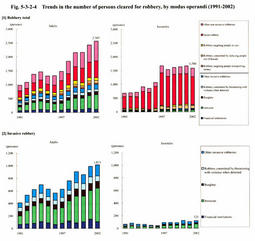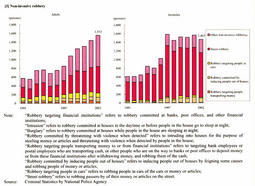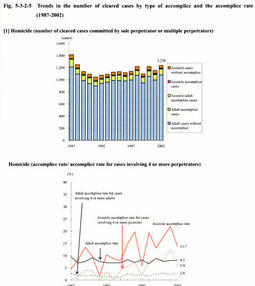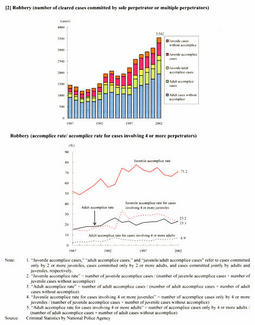| Previous Next Index Image Index Year Selection | |
|
|
2 Characteristics of juvenile heinous offenders, by modus operandi -Compared with adult offenders- (1) Characteristics of modus operandi employed by juvenile robbery offenders A remarkable increase in the number of juvenile robbery offenders has been revealed so far. Are there any distinguishing characteristics in their modus operandi compared with adult offenders? Fig. 5-3-2-4 shows the trends in the number of adults and juveniles cleared for robbery, by modus operandi, since 1991 when the number of juvenile robbery offenders started to increase. With respect to modus operandi, the most characteristic feature of juvenile robbery offenders compared with adult offenders is the wide gap in the rate of invasive robbery to non-invasive robbery. More specifically, the rate of invasive robbery to non-invasive robbery is 4 to 6 or 5 to 5 among adult offenders whereas the rate is 1 to 9 or greater among juvenile offenders, which indicates that the majority of juvenile robbery offenders have committed non-invasive robbery, mainly committing street robbery.
The recent increase in the total number of adult robbery offenders is mainly due to the increase not only in the number of non-invasive robbery offenders including those who have committed street robbery but also in the number of invasive robbery offenders including those who have committed robbery involving intrusion into stores and houses (in the daytime or before people in the house go to sleep at night). On the other hand, the recent increase in the total number of juvenile robbery offenders is exclusively due to the increase in the number of non-invasive robbery offenders, and in particular those who have committed street robbery. From 1991 to 2002, the number of adults cleared for robbery, invasive robbery (robbery involving intrusion), and non-invasive robbery (street robbery) increased about 2.6-fold, 2.5-fold (3.9-fold), and 2.7-fold (2.6-fold) respectively, whereas the number of juveniles cleared for these types of robbery increased 2.3-fold, 1.8-fold (3.2-fold), and 2.4-fold (2.4-fold) respectively. By time zone of the offense, as mentioned in Chapter 2, Section 3, the number of robbery cases committed in the nighttime, and in particular late at night (from 10:00 p.m. to 2:00 a.m. in the next morning), has been increasing significantly. Considering this trend in combination with the fact that the majority of juvenile robbery offenders have committed street robbery, it is presumed that the increase in the number of juveniles who have committed street robbery in the nighttime, and in particular late at night, may be one of the factors that has been driving up the total number of persons cleared for robbery (for details, see Chapter 4, Section 2 ). Fig. 5-3-2-4 Trends in the number of persons cleared for robbery, by modus operandi (1991-2002) (2) Increase in the number of heinous offenses committed by juvenile groups Fig. 5-3-2-5 shows the number of cleared accomplice cases of homicide and robbery committed by multiple adult/juvenile perpetrators and the accomplice rate since 1987.
As for homicide, the number of cleared cases involving juveniles has been quite small. The majority of cleared cases of homicide have been committed by adult offenders, including only a small number of accomplice cases (cases involving 2 or more perpetrators). With respect to the rate of the number of cases involving 2 or more perpetrators to the total number of cleared cases (accomplice rate) and the accomplice rate for cases involving 4 or more perpetrators, both rates have been generally higher for offenses committed by juveniles than those for offenses committed by adults, and they seem to be on a slight upward trend, though fluctuating significantly from year to year due to the small number of cleared cases. As for robbery, juveniles accounted for 38.2% of all persons cleared in 2002. However, cleared cases involving juveniles (including cases jointly committed by juvenile and adult offenders) only accounted for 28.4% of all cleared cases, and the number of cases involving sole juvenile perpetrator was much smaller than that involving sole adult perpetrator. The accomplice rate for robbery committed by adults has been within a range from 15.3% to 26.5% whereas the rate for robbery committed by juveniles has been at a higher level, from 48.7% to 77.8%, increasing by 19.2 points from 52.0% in 1987 to 71.2% in 2002. The accomplice rate for cases involving 4 or more perpetrators, which clearly shows an upward trend in the number of offenses committed by groups, has also been rising for offenses committed by juveniles, from 15.5% in 1987 to 23.1% in 2002. Such an increase in the number of robbery offenses committed by 2 or more juveniles or juveniles in groups has an influence on damage caused by perpetrators to victims. More specifically, when 2 or more juveniles or a group of juveniles commit robbery, they tend to act violently, due to the group mentality, to an extent that could not be imagined if they were committing robbery alone, and they would cause damage that is more serious than intended to victims. There is concern over the future of such trend for robbery to be committed by multiple perpetrators or perpetrators in groups (for the relationship between the increase in robbery offenses committed by multiple juvenile perpetrators and the seriousness of injuries suffered by robbery victims, see Chapter 4, Section 2 ). Fig. 5-3-2-5 Trends in the number of cleared cases by type of accomplice and the accomplice rate (1987-2002) |



